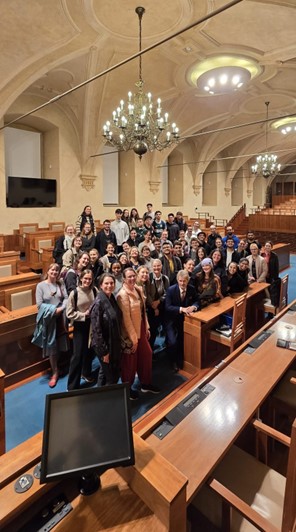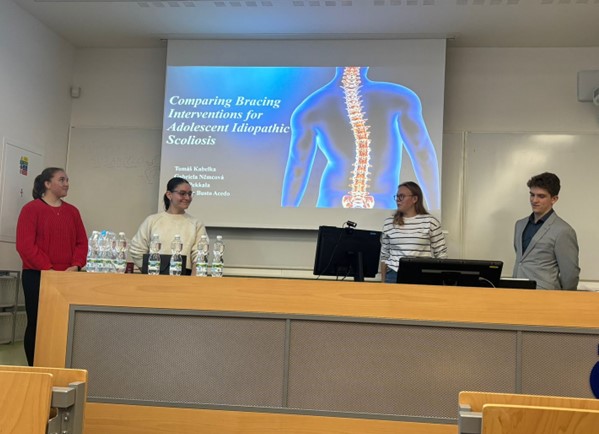
Savonia Article Pro: Comparing Bracing Interventions for Adolescent Idiopathic Scoliosis
Savonia Article Pro is a collection of multidisciplinary Savonia expertise on various topics.
This work is licensed under CC BY-SA 4.0
Introduction
Evidence-Based Physical Therapy (EBP) uses the best research evidence with clinical expertise and user’s preferences to produce the most appropriate and effective care. At week 43 in 2024, we had Blended Intensive program (BIP) in Czech Republic, Charles University about EBP. This BIP program opened with welcome words of the president of The European Network of Physiotherapy in Higher Education (ENPHE) and followed with the basis of EBP and teachers who highlighted the main challenges at different Physical Therapy fields.
More than 43 physiotherapy students and 9 teachers from five universities (Savonia University of Applied Sciences, Finland, Universidade da Coruña, Spain, Charles University Prague, Universidad Europea de Madrid, Spain and CEERRF, France (Picture 1)), actively participated this week and shared experiential group dynamics and social activities. Students worked together and wrote articles devoted to the following themes: Evidence Based in sport, prevention, injuries, neurological diseases, respiratory diseases, cardiovascular diseases, children and older adults. In this learning task, students practiced conducting a mini review and using PEDro scale to assess the quality of a studies. In the following you can consult the work presented by the students on adolescent idiopathic scoliosis topic.

Background
Adolescent idiopathic scoliosis (AIS) is a structural deformity of the spine which has unclear etiology, being a common problem in children. Bracing is supposed to prevent further progression of pathological spine curving to the point which would require surgical progression. The aim of this review is to explore what is the most effective bracing interventions for adolescent idiopathic scoliosis.
Methods
The eligibility criteria for the studies were that they are in English language, has free full text available and are published between 2022-2024. We chose to search keywords idiopathic, scoliosis and bracing. The search was made to two different databases, PubMed and Scopus.
Results
A total of 2.920 records were found. After applying the eligibility criteria there were 165 records from PubMed and 73 records from Scopus. We wanted to include randomized controlled trial studies for the review because of the higher scientific evidence. We added that criteria for the PubMed which left 15 results. Finally, 4 articles were chosen for analysis (Cheung et al. 2024, Charalampidis et al. 2024, da Silveira et al. 2022, Zapata et al. 2024). (Picture 2.)

Characteristics of included studies
Cheung et al. (2024) found that the gradually weaning of the brace wear doesn´t result in better curve magnitude.
Charalampidis et al. (2024) showed that nighttime bracing 8 hrs/day is more effective than just physical activity itself – slowed the progression of the curve of 6° or less in 76% of the patients compared to the control group.
Silveira et al. (2024) compared the effect of short-term (24 h/day, for 1 day) bracing intervention and long-term bracing with rehabilitation exercise (15-18 h/day, for 6 months). Short-term use has shown reduction of 12° in the Cobb angle, even more significant effect size compared to 5.3° reduction after six months of brace with the exercise. Results also implicated a better distribution of the plantar load and a significant increase in the body sway in static balance.
Finally, the Case Series from Zapata et al. (2024) objectively measure brace wear adherence in nighttime bracing and the influence of adherence on the curve progression. They concluded that patients treated with nighttime bracing have a high rate of brace adherence, and that the lack of curve progression is associated with increased brace wear.
Quality Evaluation
PEDro scale showed that the first three studies have high quality(9/10 points,9/, 8/10, respectively)And the last Case Series article study got 2/10 but addressed an importance variable (adherence) inot analysed in the previous one.
Conclusion
The most effective bracing interventions are short term, nighttime after acute presentation as effective alternative to full-time bracing, and weaning the bracing as soon as possible. The topics of brace adherence and psychological effects of bracing should be taken more into consideration in future AIS research, as a support in believe of the bio-psycho-social model of the patient.
Authors
Tomáš Kabelka, physiotherapy student, Charles University, Czech Republic
Gabriela Němcová, physiotherapy student, Charles University, Czech Republic
Salla Pekkala, physiotherapy student Savonia, University of Applied Sciences, Finland
Melania Busto Acedo, physiotherapy student, University of A Coruña, A Coruña, Spain
Dagmar Pavlu, Physiotherapist, Assoc. Prof. Charles University, Czech Republic
Ivana Vláčilová, Physiotherapist, PhD., Charles University, Czech Republic
Marja Äijö, PT, PhD Principal Lecturer of gerontology and rehabilitation, Savonia, University of Applied Sciences, Finland.
Veronica Robles García, PhD. PT. OT. Lecturer, University of A Coruña, A Coruña, Spain.
Beatriz Martínez Toledo, PT. University of A Coruña, A Coruña, Spain.
Montserrat Fernández, PT, University of A Coruña, A Coruña, Spain.
Lorena Canosa Carro, PT, MSc, PhD. Lecturer at Universidad Europea de Madrid, Spain.
Adrien Pallot, PT, MSc, Lecturer at CEERRF, France
References
Cheung, P. W. H., Chan, O. K. O., Wu, H., Lai, M. K. L., Wong, L. P. K., Tang, S., & Cheung, J. P. Y. (2024). Immediate vs Gradual Brace Weaning Protocols in Adolescent Idiopathic Scoliosis: A Randomized Clinical Trial. JAMA pediatrics, 178(7), 657–668.
Charalampidis A, Diarbakerli E, Dufvenberg M, Jalalpour K, Ohlin A, Ahl AA, Möller H, Abbott A, Gerdhem P; CONTRAIS Study Group. Nighttime Bracing or Exercise in Moderate-Grade Adolescent Idiopathic Scoliosis: A Randomized Clinical Trial. JAMA Netw Open. 2024 Jan 2;7(1):e2352492. doi: 10.1001/jamanetworkopen.2023.52492. PMID: 38285447; PMCID: PMC10825714.
da Silveira, G. E., Andrade, R. M., Guilhermino, G. G., Schmidt, A. V., Neves, L. M., & Ribeiro, A. P. (2022). The Effects of Short- and Long-Term Spinal Brace Use with and without Exercise on Spine, Balance, and Gait in Adolescents with Idiopathic Scoliosis. Medicina (Kaunas, Lithuania), 58(8), 1024. https://doi.org/10.3390/medicina58081024
Zapata, K. A., Virostek, D., Ma, Y., Datcu, A.-M., Gunselman, M. R., Herring, J. A., & Johnson, M. E. (2024). Outcomes for nighttime bracing in adolescent idiopathic scoliosis based on brace wear adherence. Spine Deformity, 12(3), 643–650. https://doi.org/10.1007/s43390-024-00835-w